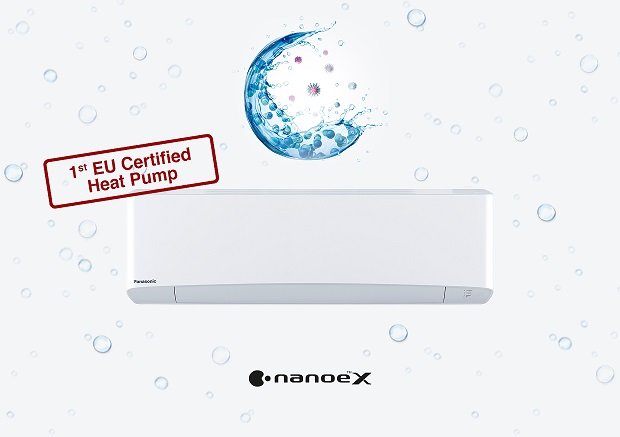Panasonic announced that, in a European first, Texcell*1, a global contract research organisation, has certified the inhibitory effect on the novel coronavirus (SARS-CoV-2) by an air conditioner with nanoe X. Texcell verified 91.4% of the inhibitory effect on the novel coronavirus in a space of 6.7m3 over 8 hours.
nanoe X is a technology that collects invisible moisture in the air and applies a high voltage to it to produce “hydroxyl radicals contained in water”. Hydroxyl radicals inhibit the growth of pollutants such as certain bacteria and viruses. They are characterised by being strongly oxidative and highly reactive, hence a short life span. Contained in tiny water particles, nanoe X has a long lifespan and can spread over long distances. It has an inhibitory effect on both airborne and adhered substances.
In September 2020, and in collaboration with Texcell*1, Panasonic verified the inhibitory effect of the nanoe X technology with the benefits of hydroxyl radicals on the novel coronavirus in a small test space of 45L using nanoe X generator. For further investigation, Panasonic challenged to test using an air conditioner with nanoe X in a larger test space. Even in these difficult circumstances, Texcell has now certified that the nanoe X does have a 91.4% inhibitory effect on the novel coronavirus in the actual space of 6.7m3 over 8 hours using the air conditioner with nanoe X. This testing was carried out in a closed laboratory environment and was not designed to assess its efficacy in uncontrolled living spaces.
Panasonic has been conducting research on nanoe TM Technology over the past 20 years since 1997 and has verified its effectiveness in a variety of areas, including inhibiting pathogenic microorganism (bacteria, fungi, and viruses) and allergens, breaking down PM 2.5 components that have adverse effects on the human body*2.
Panasonic will continue to pursue the potential of nanoe X technology to address possible risks associated with air pollution such as new pathogenic microorganisms, to create healthy environments for people around the world.
Notes:
*1: Texcell is a global contract research organisation that specialises in viral testings, viral clearance, immunoprofiling and R&D or GMP cell banking, for your R&D, GClP, GLP and GMP projects.
With more than 30 years of experience and roots within the Pasteur Institute in Paris, Texcell has a long recognized expertise in viral testing with a broad range of protocols for the detection of adventitious agents.
Texcell is the first spin-off of the Pasteur institute of Paris created in 1997.
*2: Main releases on verification cases
- May 12, 2009:Positive effects of charged water particles on viruses, bacteria, and agricultural chemicals have been verified.
- October 20, 2009: The new influenza virus inhibition effect of charged water particles has been verified.
- February 20, 2012:Suppression effect of charged water particles on pet-related allergens, bacteria, fungi, and viruses have been verified.
- January 16, 2014:Nano-sized electrostatic atomised water particles effectively breaks down PM2.5 components and inhibits growth of fungi attached to Yellow Sand.
